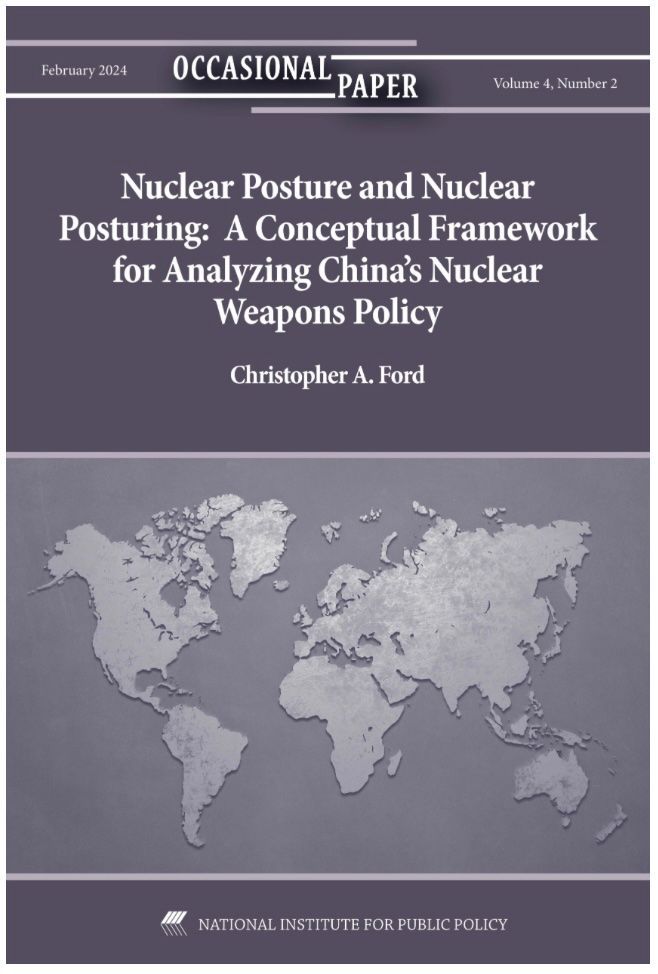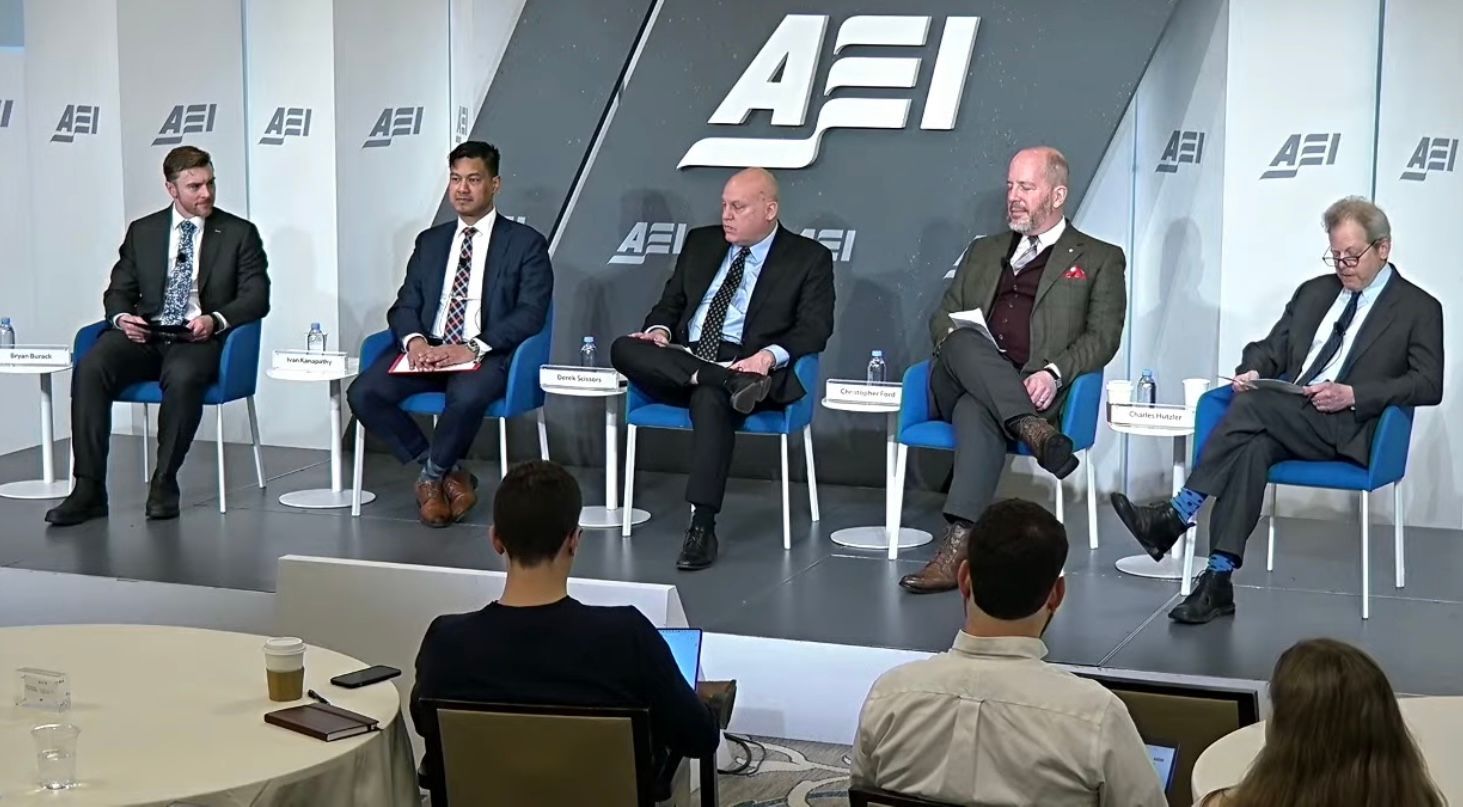The Hon. Christopher A. Ford
New Paradigms Forum -- International Security Policy Since 2009
A Nuclear-Armed Iran in the Future Security Environment
Note:
Dr. Ford gave the following presentation to a conference on " The Strategic Implications of the Iranian Nuclear Program " sponsored by the Aspen Institute Germany, and held in Berlin on September 22-24, 2010. It is reproduced here with Aspen’s kind permission.
Let me begin by offering my thanks to the Aspen Institute in Germany for organizing this conference. I know from experience that it is difficult for those in government to talk about the strategic implications of an Iran armed with nuclear weapons. To some extent, even to be seen to be engaged in such thinking might be taken as an admission of anticipated defeat in the ongoing diplomatic confrontation between the clerical regime in Tehran and those who seek to hold it to its obligations under International Atomic Energy Agency (IAEA) safeguards, the Nuclear Nonproliferation Treaty (NPT), and legally-binding resolutions of the United Nations Security Council. Mere contingency planning, of course, is in reality no such admission, but the political “optics” of the ongoing confrontation too often tend to stifle open debate. That is why it is particularly valuable for institutions such as the Aspen Institute to study such issues.
So how shall we think about a potential future nuclear-armed Iran?
I. Iran and Nuclear Weaponry
Some commentators, particularly in the United States and in Israel, worry tremendously about the possibility that Iran would actually use nuclear weapons against Israel, or that it might supply nuclear technology (or perhaps weapons themselves) to one of its many terrorist clients around the world. Not everyone agrees on the likelihood of such events.
As I see it, one cannot rule out some spasm of annihilative eschatological enthusiasm from a regime that is already deeply radicalized and militarized, and within a Shi’ite tradition that has both powerful traditions of martyrdom and pronounced millenarian tendencies. Nevertheless, my own feeling is that such direct or indirect nuclear use is relatively unlikely absent some deep existential crisis for the clerical regime. It is a worry – and is undeniably part of the landscape of possible futures against which we should be testing our strategic and contingency thinking – but it is not my first worry.
Iran’s acquisition of nuclear weapons also raises the troubling possibility, however, of the unplanned use or loss of control over a nuclear device or related technology – by accident or through incompetence and inexperience, or perhaps as the result of reckless adventurism by some splinter faction within the regime’s already disturbingly radicalized Pasdaran force (a.k.a. the Islamic Revolutionary Guard Corps). The advent of an Iranian nuclear weapons capability would such “inadvertence” scenarios an ongoing worry.
But whatever one thinks of the question of direct or indirect nuclear weapons use – in the sense of an actual detonation, rather than simply the employment of implicit or explicit nuclear threats in bargaining and intimidation scenarios – there seems to be little disagreement that an Iran with nuclear weapons is very likely to feel greatly empowered and emboldened within its region by the possession of a nuclear weapons capability. This, in my view, is the basic strategic issue driving most other countries’ reactions to the developing Iranian nuclear crisis.
A nuclear-armed Iran might well conclude that it has immunized itself against what its officials have sometimes termed “extra-territorial invasion,” which basically means that its revolutionary Shi’ite leaders would no longer feel any danger that engaging in egregious regional provocations might bring down upon them forcible, foreign-led regime change of the sort that toppled Saddam Hussein in Iraq and the Taliban regime in Afghanistan. Given the degree to which Iranian regional assertiveness is already destabilizing the region – even without nuclear weapons – this is surely a very serious concern.
For years, Iran has been sponsoring terrorists and other fighters targeting Israel, offering ongoing support for those killing allied troops and local citizens alike in Afghanistan and Iraq, sponsoring the development of Hezbollah as a disruptive state-within-a-state in Lebanon, working to sabotage the peace process between Israel and the Palestinians, and periodically meddling in antigovernment politics in regional states (particularly, but not exclusively, among the substantial Shi’ite populations of the Gulf). The regime in Tehran has a strong sense of self-identity as a revolutionary state with a feeling of sectarian mission within Islam, as well as ambitions actually to lead the entire Muslim world against its perceived enemies. This religious enthusiasm also overlays a self-identity as a Persian culture – indeed, the modern inheritor of one of the most glorious empires of antiquity – that has been humiliated in modern times and denied its rightful place as the leading state in the Middle East. How might such attitudes manifest themselves in regional behavior if nuclear weapons are felt to preclude foreign invasion?
It is not clear the precise degree to which Iran’s present-day leaders consider themselves to be constrained by the possibility that engaging in regional or other provocations might bring about their ouster, as it were, at the tips of foreign bayonets. Iran frequently claims , at least, to feel an acute threat of foreign intervention. (It has, for instance, explicitly advanced this as a rationale for purchases of advanced foreign military technology, such as the rocket-powered Shkval torpedo and what appears to be the recently-aborted sale of the S-300 air defense system from Russia.) Not surprisingly, perhaps, many foreign analysts feel such fears also to be one of the motivations behind Iran’s continuing pursuit of a nuclear weapons capability.
The Iranian regime’s victim-narrative, of course, describes Iran as being subject to wanton and undeserved foreign threats – and would no doubt publicly justify nuclear weaponization in such terms. Foreign observers tend to worry, however, that Iran’s revolutionary leadership really yearns to chart a course no longer conditioned by the fear that aggressive actions might precipitate their own ouster. (From this latter perspective, the key analytical point is precisely the degree to which foreign threats would not be “undeserved.”) Either way, it seems reasonable to suppose that not all of Iran’s emphasis upon the perceived foreign threat is empty and cynical bluster, designed solely for propaganda purposes and to justify the development of capabilities actually desired for other reasons. Yet granting any reality to Iran’s claim (for whatever reason) to fear outside intervention implies, in turn, that Iran’s behavior would be different – and in some sense inherently less constrained – after it has acquired nuclear weapons.
II. Bandwagoning versus Balancing
If any of Iran’s loudly-proclaimed fear of outside intervention is real, it stands to reason that Iran will indeed feel to some real extent empowered and emboldened by nuclear weapons possession. Many fear that this means Iran will thereupon prove more aggressive, less restrained, and freer to indulge whatever revolutionary and/or hegemonic predilections its government may happen to have.
This certainly seems to be the assumption of Iran’s neighbors, at least, who have for years privately expressed alarm at Iran’s rise as a regional power and its concomitant nuclear weapons ambitions, and who have begun in recent months to break their public silence on the subject. In June 2010, for instance, Ambassador Yusef al-Otaiba of the United Arab Emirates told a conference that “[w]e cannot live with a nuclear Iran,” and that he would be willing to support a U.S. military strike on Iran in order to prevent it from crossing the weapons threshold. Also this spring, Egyptian Ambassador Abdel Aziz told journalists at the NPT Review Conference that if Iran develops nuclear weapons, the Egyptians would “not ... accept to be second-class citizens” in the region, and that “Egypt and ... all the countries in the Arab world” might “change their mind” about nonproliferation commitments.
More quietly, multiple regional states – notwithstanding the oil resources some of them possess – are moving forward with plans to develop nuclear energy capabilities, which many observers interpret as “strategic hedging” designed to give them a nuclear technology base in case Iran’s nuclear program cannot be stopped and they wish to move ahead with developing a countervailing capability of their own. Egypt has ambitious plans for nuclear energy development and has already had problems with the IAEA over undeclared fissile material production experiments, Jordan has refused to forswear fissile material production, Turkey recently announced plans to begin construction of a nuclear reactor by 2014, and famously oil-rich Saudi Arabia has declared its intention to develop uranium enrichment. Not surprisingly, this has led many observers to fear a “cascade” of proliferation if Iran’s nuclear-fueled regional ambitions cannot be frustrated.
Just how such a cascade develops, however, will be shaped by Iran’s own nuclear choices and by the choices of outside players. It may be hard to prevent the further proliferation of dual-use capabilities – including the critical nuclear weapons-facilitating technology of fissile material production – to regional states. The degree to which other states in the region cross the line into actual weaponization, however, will presumably depend upon how Iran approaches this threshold itself.
Overt weaponization in Iran would maximize the pressure on other regional players to follow suit, particularly in Turkey and Egypt, which have historically played the role of regional balancer against Persian ambitions, and which entertain pretensions to regional leadership even today. As Ambassador Azziz’s comments suggest, the current government of Egypt, a proud but brittle regime now facing leadership succession problems and terrified of Islamic radicalism, seems to have no illusions about the nature of the regional challenge presented by Iran’s rise. Barring dramatic changes in Turkey’s own sense of regional and religious identity, moreover – changes which are conceivable but still seem unlikely, even given the vaguely Islamist inclinations of its current government – Turkey’s current confluence of interests with Iran, which runs to carving out a regional leadership role for Ankara as a mediator in crafting diplomatic alternatives to Western nonproliferation sanctions, may not survive Tehran’s success in developing nuclear capabilities and claiming regional leadership for itself. Either or both of these countries might find themselves feeling strong incentives to follow Iran’s nuclear path.
Covert Iranian weaponization – perhaps self-consciously modeling itself upon the strategy most observers claim Israel to have taken, and perhaps even adopting and mocking Israeli pronouncements about not being the first to “introduce” nuclear weapons into the Middle East – might reduce this pressure, though perhaps not too much. Even if Iran opts to linger on the brink of weaponization as a “virtual” nuclear weapons state, however, it would seem very difficult to prevent the development of a region increasingly populated by “latent” weapons states, all “hedging” against each other in a tense and perhaps quite unstable balance.
Another critical variable will be whether regional Arab governments confronted by nuclear-facilitated Iranian efforts at regional hegemony choose to respond by a strategy of “bandwagoning” or to respond with one of “balancing.” It would be neither impossible nor entirely out of keeping with local political traditions for many regional players to conclude that Iran’s rise is, for practical purposes, unstoppable – and that the best chance for security is thus to associate themselves with it in some fashion, such as by reaching an accord with Tehran that would permit existing regimes to remain in power as tolerated semi-clients within an Iranian sphere of influence. I doubt that such bandwagoning would stop the development of “latent” nuclear capabilities in some regional states, but it would presumably reduce the likelihood of countervailing weaponization – albeit at the cost of de facto political subordination.
Alternatively, regional states could band together to resist Iranian domination in classically anti-hegemonic balance-of-power configurations. Especially were an activist role adopted by traditional anti-Iranian (or anti-Perisan) balancers such as Turkey and Egypt, regional counter-balancing behavior is possible even if outsiders stand entirely aside. Yet outside powers would still presumably have a great deal of influence upon whether or not such a “balancing” strategy seemed attractive to regional players. Their support for and involvement in anti-Iranian geopolitical maneuvering could help make balancing seem much more attractive, and bandwagoning unnecessary.
Whether or not such anti-hegemonic mobilization receives the encouragement and support of powerful foreign allies would presumably also affect the likelihood of countervailing nuclear weapons development. “Balancing” states, in other words, might be content to remain non-nuclear if they felt their security adequately underpinned by foreign relationships, even though they might find little alternative to accommodation if left on their own. Here too, the willingness of outside powers to play an activist role against Iranian domination of the region will profoundly shape the evolution of the regional security environment. Such outside activism, in fact, might offer the only real chance to navigate between the Scylla of Iranian hegemony and regional bandwagoning, and the Charybdis of a dangerous nuclear-armed standoff between Iran and an anti-hegemonic coalition of regional rivals.
For the foreseeable future, the only outside power I see as being in any sort of a position to play such a mobilizing and channeling role is the United States – though success in this regard after Iran’s acquisition of nuclear weaponry might well require a politically-incorrect degree of sustained attention to maintaining or improving American military capabilities in order to keep full-scale intervention alive as an option credibly “on the table” without any U.S. recourse to its own nuclear weaponry. (This could entail, for instance, augmented active and passive defenses for the United States and its regional allies against potential forms of nuclear delivery, as well as improved capabilities to conduct expeditionary military operations in a weapons of mass destruction [WMD] environment. The aim would be to minimize the degree to which American military power will be – or be seen to be –“deterred” by Iranian nuclear weapons possession, thus denying Tehran much of the strategic benefit it may hope to acquired by such means.) At the very least, the United States would need to ensure that its global power-projection capabilities do not atrophy despite the financial pressures attendant to what has now become a shocking degree of federal government indebtedness.
I see little prospect of Russia playing a role in shoring up Middle Eastern balancing behavior vis-à-vis an aggressive and nuclear-empowered Iran, partly as a result of its lack of capability and partly due to its apparent lack of interest. If anything, Russia still seems tempted to regard Iran’s development at least of a “virtual” nuclear weapons capability as something quite consistent with the Kremlin’s strategic interest. To the extent that Iranian regional hegemony would present a grave setback to American strategy in the Middle East, Russia may find it congenial. (For an authoritarian regime of siloviki functionaries pining for their lost empire and global stature, anything which undermines the power of its old superpower rival might seem intrinsically pleasant.) Provided that Iran did not turn its Islamic revolutionary gaze northward into the Caucasus, moreover, regional instability provoked by Iran’s rise could help keep Russia’s corrupt, ill-managed, and still-undiversified petroleum-based economic monoculture afloat by ensuring that global oil prices remain high. Such factors – and not merely the short-term financial gain to be had from technology exports – may help explain the Kremlin’s willingness to constrain U.S. sanctions efforts at the U.N. Security Council, to help Iran with the construction of the Bushehr nuclear reactor, and (at least until recently) to sell it advanced military technology.
China’s situation is more complicated. Beijing sometimes seems tempted today to facilitate or protect Iranian self-assertion against the United States, perhaps also in classically power-balancing way intended to weaken Washington’s strategic position while helping ensure a thirsty China’s continuing access to plentiful supplies of Iranian oil. Ultimately, however, it is not necessarily in Beijing’s interest to see Iran’s regional ambitions unsettle the Middle East. Having become the world’s largest consumer of fossil fuels, China badly needs long-term stability in the Middle East and continued access to oil. At some point, therefore, any interest Beijing may now feel in dragging its feet in the face of Iran’s destabilizing rise could be overwhelmed by its interest in regional peace. (A Sino-Iranian condominium built around a Chinese “big brother” offering augmented regime protection to Iran in return for preferential oil access would be a strategic gamble, and could backfire, from Beijing’s perspective, if the very solidity of such an accord further enticed Iran into adventurism or sparked vigorous – and perhaps outside-supported – counter-mobilization.) Which way China’s perceived interests eventually lead it is, at this point, anyone’s guess.
India’s future role in the region is, if anything, even more ambiguous. New Delhi seems presently to be neither prepared for nor interested in an activist great power role that far afield. Nevertheless, over the medium or long term India is not badly positioned for such endeavors, particularly with the growth of its naval power and its emerging semi-competitive strategic relationship with a China that seems itself steadily to be acquiring interests and a growing role far from its own shores. Inherited Cold War-era political prejudices notwithstanding, one should not even rule out the possibility of an eventual Indo-American alliance, particularly if China should begin to develop a more activist and perhaps less benign role in the Middle East.
Such possibilities, however, still seem distant. For the moment, there seems little prospect of an activist outsider role vis-à-vis anti-Iranian “balancing” that does not somehow involve Washington.
III. International Regimes
But what about the impact of a nuclear-armed Iran upon the international nonproliferation regime? That regime would clearly suffer an enormous blow to its credibility and probably its long-term integrity if Iran, an NPT signatory non-nuclear weapons state, were permitted to develop nuclear weapons. If one conceives of the nonproliferation regime as a bundle of inter-related agreements, institutions, norms, customs, and behavior patterns – including but by no means limited to the Nonproliferation Treaty itself – revolving around the animating idea that international peace and security is best served if the further proliferation of nuclear weaponry can be prevented, Iranian nuclear weapons development might not be quite fatal, even coming on the heels of a similar failure in North Korea. The nonproliferation regime, however, could hardly be anything but further, and gravely, weakened – and the prospects for nuclear weapons abolition all but destroyed.
A nuclear-armed Iran could also affect dynamics of how international regimes operate more generally as well. Despite the military successes of the troop “surge” begun by the United States in Iraq in 2007 – and the uneasy quasi-peace into which that troubled country has since begun to settle – it is sometimes said that the long struggle of the Iraq war gave nonproliferation “unilateralism” a bad name. Notwithstanding the analytical fallacy of assuming that the difficulties of suppressing sectarian violence and guerrilla insurgency in Iraq had much of anything to do with who participated in the invasion, this observation makes an important point about the psychology of participants in the broader nonproliferation regime. Though initially the prospect of regime change in Iraq undertaken in response to purported WMD threats seems to have had a salutary effect upon the behavior of other proliferators – with Iran apparently temporarily suspending some work on nuclear weaponization in mid-2003, and Libya agreeing later that year to relinquish its various WMD programs – it did not take long for Iraq to sour many on the idea of muscular counter-proliferation or military intervention of any sort. Iran has benefited from that souring.
With this general swing of opinion against intervention per se having been exacerbated by what appears to have been a broad feeling that the United States had become too powerful and too willful, and needed to be taught something of a lesson, the psycho-political pendulum within the nonproliferation regime for a time swung quite emphatically in favor of an exclusive focus upon using “softer” means for accomplishing nonproliferation goals. For some participants – such as the three European governments that cut their own “unilateral” diplomatic side-deal with Iran in 2003, an accord that did not stop Iranian nuclear developments but which successfully derailed for some years the U.S. effort to work the Iran issue multilaterally through the IAEA to the Security Council pursuant to the IAEA Statute – the shift seems to have been entangled with desires for some kind of political “payback” for Washington’s enthusiasms in Iraq, perhaps coupled with a demonstration to the arrogant Americans of the “right” ( i.e., diplomatically non-confrontational) way to approach nonproliferation.
Others, particularly in the developing world, may have had some real sympathy for the Iranians – at least initially – as plucky underdogs facing down the mighty powers of the world, or may have felt an affinity for Iran’s conveniently self-exonerating narrative that the real story here was less about preventing proliferation than about predatory Western nuclear technology “haves” further oppressing “have nots” in less developed countries. Whatever the causes, however, the swing of the psycho-political pendulum within the nonproliferation regime against the very idea of military intervention seems to have been significant – and was only underlined by the coming to power in the United States of a new president who had fiercely opposed the war in Iraq and who was determined to win acclaim for not being anything like his predecessor.
But here lies the significance of subsequent developments in Iran, for the current situation suggests that diplomacy-focused “multilateralism” and the congenially non-sanguinary tools of “soft power” may now themselves be being given a “bad name” inasmuch as they are proving conspicuously unable to arrest Iran’s trajectory toward nuclear weapons. An Iran armed with nuclear weapons could thus impel a new pendular movement, for it could be taken to offer a lesson in the ineffectiveness of peaceable methods when confronting a determined proliferator.
One possible lesson of a nuclear-armed Iran might be that nonproliferation compliance enforcement is simply not possible at all, its “hard” version having become self-deterringly costly and its “soft” version having simply proven ineffectual. Such a conclusion would represent the collapse of the nonproliferation regime into a merely hortatory system – a scheme of unenforceable virtue ethics in an environment that still seems to present participants with powerful incentives for misbehavior. The potential proliferation consequences of such an institutional implosion are not hard to imagine.
An alternative lesson, however – and it is naturally quite possible that different players will reach different conclusions – might be to conclude that anyone serious about nonproliferation must be willing to intervene early in a developing proliferation crisis after all, and by force of arms if necessary, since the Iran case demonstrates that no “softer” approach can be relied upon. By this view, the Americans might in a sense actually be seen to have had a point in conceptualizing the possibility of counter-WMD preventative war, even if they did undertake their invasion of Iraq on mistaken premises and ended up mishandling its occupation in bloodily tragic ways.
The lessons of Iran could thus have important implications for use-of-force issues in the international community more generally. As I have discussed elsewhere, some international lawyers have tried to argue that the very existence of the U.N. Charter system precludes resort to force without Security Council authorization except in the most immediately threatening of circumstances. Yet it is toward just such violent “self-help” prophylaxis that the collapse of compliance enforcement in the nonproliferation regime may end up pushing the international community.
If there is a cogent argument to be made for restricting preventative war to Council-authorized circumstances, it revolves around such formal institutional mechanisms being able to offer an effective replacement for national self-help. With regard to the use of force in counter-proliferation, however, the Iran-related unraveling of NPT compliance enforcement may make this untenable. In an era characterized by worsening WMD proliferation threats, but also by the disintegration of hopes for effective multilateral nonproliferation compliance enforcement short of war and the de facto non-availability of officially “authorized” force, compliance enforcement might end up being effectively “privatized” under the rubric of Article 51 “self-defense.”
The international community, in other words, may come to rely, more explicitly than ever, upon the individual efforts, commitment, and capabilities of a small number of muscular players willing – entirely on their own – to shoulder the burden of providing what an economist might describe as a “public good” of compliance enforcement that would otherwise be radically “underproduced.” (Under the circumstances, moreover, this may not actually be such a bad answer. The rule of law in international affairs is arguably better served if it is enforced improvisationally and unilaterally by a few strong players than if it is not enforced at all.)
This is a policy and legal debate that was already well underway in nonproliferation circles long before the Iraq war. My point here, however, is not that these issues are likely to be resolved any time soon, but that the story of the last decade’s events in the Middle East – and the rise of a nuclear-armed Iran – may ultimately end up reinforcing, rather than undermining, the critique of multilateralism that helped lead to the invasion of Iraq. Future generations’ view of WMD-related “self-defense,” and of the availability and advisability of preventative violence, will be shaped by whether diplomatic multilateralism shows itself capable of handling the Iranian challenge.
IV. Narratives of Identity
Let me now say a final word about Iran’s potential impact upon what one might call competing overall visions of the Middle Eastern strategic environment. The Middle East may be today at a watershed point between narratives, a juncture at which new and emerging storylines compete in order to re-organize perceptions of the region and its trajectory.
For many years, views of the Middle East seemed to be structured around several basic sets of tensions. The region as a whole may have been defined by outsiders in a vaguely civilizational sense – with the “Middle East” being seen, in affirmative terms, as a region generally characterized by aridity, oil, and Islam, as well as in negative space by virtue of not being European, African, or Asian – but its key internal polarities did not then seem to have much to do with civilizational indicia. Rather, the Middle East found itself living out a series of dynamic tensions between systemic and national identities.
With Ottoman imperial rule having collapsed and been succeeded by a time of European colonial power that then itself soon began passing into history, the region was strung by the mid-20 th Century between claimant post-colonial identities. In that new world, emergent nationalist enthusiasms – expressed, in Arab regions, at least, either as an emergent pan-Arabism or as a more localized national identity, with these two nationalisms themselves sometimes very much in tension with each other – coexisted awkwardly with more systemic identities rooted in narratives that located Middle Eastern peoples and states within broader clashes of politico-ideological identity along capitalist/socialist lines or what came to be called North/South issues of economic development. This broad post-colonial tension was itself then overlaid by the geopolitical rivalry of the Cold War, the politico-military and ideological demands of which to a degree reinforced the region’s polarities, but which also to some extent encouraged the development of victim-identities opposed to any kind of “team” association with manipulative and oppressive outsiders.
Today, however, things are changing again, and all of these narratives of global and regional identity are in flux, having either been exploded outright – like the polarity of the Cold War upon the collapse of the Soviet Empire – or being under assault from various new conceptual organizing schemes. If we are to understand the long-term impact of a nuclear-armed Iran, we must explore the potential ways in which it will play into this ongoing process of identity contestation and competition between organizing frameworks.
The strategic bipolarity of the Cold War was succeeded by a narrative of American monopolarity, in which global dynamics were felt to be conditioned to a historically unprecedented degree upon strategic choices made in Washington. The United States, by this point uniquely, was a power that conceived its interests in truly global terms, and it was able to shape its strategic environment through both “hard” and “soft” means far more broadly and deeply than any other of the major powers. Today, however, this monopolar narrative is under stress in a number of ways, with opinion in many quarters shifting markedly against the sustainability of such far-flung U.S. roles and commitments for reasons ranging from politico-psychological enervation to the hobbling impact of contemporary Washington’s ruinous budget deficits.
To the extent that the monopolar storyline still retains coherence, it rests upon America’s extraordinary conventional military strength – an amalgam of global logistical reach, state-of-the-art space-facilitated communications and computer infrastructures, precision weaponry, enormous research and development investments, and highly-trained professional manpower – which no other power, or perhaps even combination of powers, can today even come close to matching. Yet the prospect of a nuclear-armed Iran offers a potentially powerful counter-narrative to the storyline of global military monopolarity, particularly if such armament were accompanied by the possession of advanced non-nuclear military technologies specifically optimized for complicating or precluding extraterritorial power projection by the American hyperpower. (It is not that such non-nuclear capabilities would allow their possessors to do anything remotely like matching American might, but rather that these techniques are intended to neutralize its most potent elements, for a time, and in a specific locality. Especially if coupled with the potential threat of nuclear weapons use, the hope presumably would be to make U.S.-style power projection seem prohibitively risky in one’s own particular case.) Assessments of the strategic impact of a weaponized Iran must thus consider the degree to which such a nuclear capability will tend to decouple the Middle East from a broader politico-military balance that still favors the United States, and the political and strategic implications of such decoupling.
Such strategic decoupling, of course, would not be entirely surprising, for this is, for Iran, presumably precisely the point. (As noted, many observers feel that one of the reasons Iran seeks nuclear weapons is to “immunize” it from the possibility of forcible regime change.) But it should be viewed not only from the perspective of its immediate impact upon the security dilemmas facing Iran’s neighbors, but also as part of a broader dynamic of re-regionalizing what had previously been a militarily globalized world – a process the long-term implications of which may be very significant indeed.
Such re-regionalization – with its accompanying implications not only for America’s global role but also with regard to the prevailing narratives of identity polarity within the Middle East – might raise important questions about who the key players (and “teams”) would come to be in regional politics. This is a particularly salient question given that one of the other key tensions of the post-colonial era – the relationship between national and systemic identity – is also today being recast. Where once the fundamentally secular identities of nationalist particularism and globally-focused politico-economic ideology confronted each other in a battle for the hearts and minds of regional players, today this tension is evolving into a contest between more-or-less secular nationalisms, on the one hand, and much broader notions of religious and civilizational identity rooted in an increasingly radicalized Islam on the other.
In a re-regionalized strategic context in which identity narratives are caught between national and religio-civilizational affiliation, a nuclear-empowered Iran could play a powerful “wild-card” role as a sort of conceptual catalyst. As a non-Arab power, a rising Iran – and its potential belligerence – could stimulate into revival an otherwise apparently waning sense of ethnic or cultural pan-Arab identity, recasting regional relations increasingly along an ancient axis of Arab-Persian tension. As a Shi’ite power, Iran could provoke a similar reaction by Sunni Islam, in a process that could either reinforce Arab-Persian dichotomies or in fact subsume and dissolve them in the sort of broader sectarianism we have seen in Iraq. And in either incarnation – Shi’ite or Persian – an Iran rising toward dreams of regional hegemony could draw forth new regional polarities with counterpoised identities clustered around “champion” states such as Turkey or Egypt, each taking advantage of overlapping polarities in which they would embody Arabism (in Egypt’s case), Sunni Islam, and/or a political ethic of religious “moderation” or even secularism in the face of Islamist revolution.
Nor should one forget that it sometimes seems to be Iran’s own ambition to transcend all these internal regional polarities, constructing instead a radicalized religious identity for the Middle East as a whole – led and inspired by Iran’s own revolution – and resurrecting a notion of strategic bipolarity on a global scale by positioning this new Islamic collectivity as the opponent of a multinational system of corrupt and iniquitous irreligion or apostasy. (In this regard, the clerical regime in Tehran might end up having more in common with stateless Sunni extremists than with other states in the region. One should perhaps not rule out their reaching an accommodation, as indeed already seems to be the case with Iran’s support for the Sunni extremists of Hamas. Anti-Israeli animus might also prove to be a potent pan-Islamic unifying force.) It is far from clear how successful this effort will be, of course, but it presents yet another competitor in the region’s complex and shifting complex of identity narratives.
My point is not to predict how Middle Eastern participants will move along these contested identity axes. Rather, it is merely to point out that Iran, and the dynamics of its rise, are pivotal to the development of the polarities presently in play in the region today.
V. Conclusion
Except insofar as almost any nuclear-armed Iran would seem to present a challenge to the integrity of the nonproliferation regime, it bears emphasis that it need not necessarily result in a catastrophically dramatic recasting of regional alliances, power dynamics, and identity complexes. An armed Iran that for some reason becomes a status quo power and is perceived as no longer being a threat to its neighbors after having seized its atom-fueled geopolitical “place in the sun,” for instance – such as through the replacement of its clerical revolutionaries, Pasdaran praetorians, and Basiji paramilitaries by genuine moderates, secularists, and/or democrats – might actually permit an era of more “normal” state interactions shorn of some of the acute systemic, sectarian, nationalist, or civilizational competitions so many observers today expect. A crisis that results in the collapse of the Islamic revolutionary government from economic pressure and domestic discontent, in fact, could actually strengthen the nonproliferation regime and help stabilize the region, particularly if such collapse produces de-nuclearization. Not all possible outcomes, in other words, fit within the “parade of horribles” genre.
My point, however, is that it is very hard to say precisely what will happen – and that many alternative futures, at least, seem likely to present grave challenges to international peace and security. As we contemplate the possibility of a nuclear-armed Iran, we must test our potential strategies against the broad landscape of possible futures, both good and bad.
Not all imaginable futures involving a nuclear-armed Iran necessarily involve dramatic regional realignments and snowballing potential instabilities. Nevertheless, many – indeed, most – would seem to, and to present significant challenges to international peace and security. We must weigh the possibility of such risky and troubled futures against the admittedly considerable costs and dangers of the steps we might have to take in order to prevent the advent of a nuclear-armed Iran.
-- Christopher Ford



Copyright Dr. Christopher Ford All Rights Reserved






